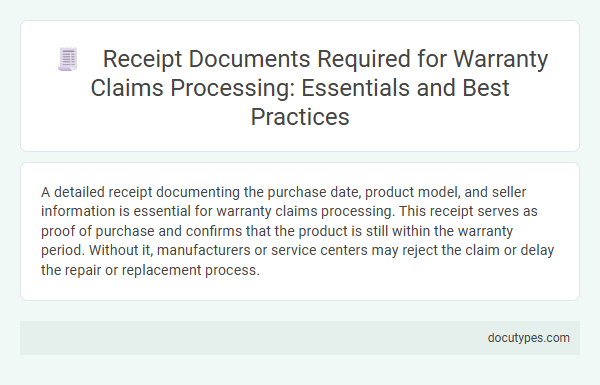A detailed receipt documenting the purchase date, product model, and seller information is essential for warranty claims processing. This receipt serves as proof of purchase and confirms that the product is still within the warranty period. Without it, manufacturers or service centers may reject the claim or delay the repair or replacement process.
Introduction to Warranty Claims and Receipt Documents
| Topic | Details |
|---|---|
| Introduction to Warranty Claims | Warranty claims allow consumers to request repair, replacement, or refund for defective products within a specified period. Processing these claims requires proof of purchase to verify product ownership and warranty eligibility. |
| Importance of Receipt Documents | Receipts serve as official purchase evidence, containing key data such as purchase date, product details, seller information, and transaction value. These elements are essential for validating warranty claims efficiently. |
| Required Receipt Information | Receipts for warranty claims must include the product name or model number, purchase date, retail store name, transaction ID or order number, price paid, and buyer's information when available. |
| Receipt Formats Accepted | Retail receipts, electronic invoices, digital purchase confirmations, and registered warranty cards with proof of purchase are commonly accepted documents for warranty claim processing. |
| Consequences of Missing or Incomplete Receipts | Claims without valid receipts may face denial or delays. Providing a complete and accurate receipt document ensures faster claim approval and better customer service experience. |
Importance of Receipts in Warranty Processing
A receipt document is essential for warranty claims processing as it serves as proof of purchase, verifying the transaction date and retailer information. Accurate receipts ensure eligibility for warranty services and facilitate smooth claim validation.
- Proof of Purchase - A receipt confirms the buyer's ownership and the purchase date necessary to validate warranty periods.
- Retailer Verification - The receipt provides specific retailer details which are required for authenticating the source of purchase.
- Purchase Details - Item description, price, and transaction ID on the receipt help verify the exact product covered under warranty.
Maintaining a clear and complete receipt is crucial for efficient and successful warranty claims processing.
Types of Receipts Accepted for Warranty Claims
A receipt document is essential for processing warranty claims, serving as proof of purchase and validating the product's eligibility. Different types of receipts may be accepted depending on the retailer or manufacturer policies.
Accepted receipts typically include printed sales receipts, electronic receipts from online purchases, and invoice documents that detail the transaction date, product description, and price. A valid receipt must clearly show the buyer's information, purchase date, and the product's serial or model number when applicable. Photocopies or digital photos of the original receipts are often accepted if legible and complete.
Essential Information on Warranty Claim Receipts
A receipt document needed for warranty claims processing must include proof of purchase, date of transaction, and detailed product information. Essential information on warranty claim receipts ensures the claim is validated quickly and accurately by the manufacturer or retailer. You should retain a copy that clearly displays the seller's details and warranty terms.
Common Mistakes in Receipt Submission for Warranty
A receipt document needed for warranty claims processing must clearly show the purchase date, product details, and seller information. Common mistakes in receipt submission include submitting blurry images, partial receipts missing crucial information, and receipts outside the warranty period. Ensuring the receipt is complete and legible speeds up the warranty verification process and avoids claim rejections.
Digital vs. Physical Receipts: Pros and Cons
Receipt documents play a crucial role in warranty claims processing, serving as proof of purchase. Understanding the differences between digital and physical receipts can help you choose the most effective option for your needs.
- Digital Receipts Offer Convenience - Stored electronically, they are easy to organize and access from various devices, reducing the risk of loss or damage.
- Physical Receipts Provide Tangibility - A printed copy can be immediately presented at stores or service centers without relying on digital devices or internet access.
- Both Types Have Limitations - Digital receipts may face format compatibility issues, while physical receipts can fade or be misplaced over time, potentially complicating warranty claims.
Best Practices for Organizing Receipt Documents
Warranty claims processing requires clear and accurate receipt documents to verify purchase details and validate the claim. Organizing these receipts efficiently helps streamline the claims process and ensures quick resolution.
- Keep Original Receipts - Physical or digital copies of the original purchase receipt are essential as they contain purchase date, seller information, and item details required for warranty validation.
- Store Receipts Systematically - Organize receipts by date, product category, or warranty expiration to facilitate fast retrieval during claims processing.
- Use Digital Backup - Scanning and saving receipts in cloud storage or dedicated apps protects against loss or damage of physical copies and allows easy access when needed.
How to Retrieve Lost or Missing Receipts
What receipt document is needed for warranty claims processing? A detailed sales receipt showing the purchase date, product description, price, and retailer information is essential. This verifies proof of purchase and eligibility for the warranty service.
How to retrieve lost or missing receipts for warranty claims? Contact the retailer or store where the purchase was made; many keep digital records for a certain period. Check email archives for electronic receipts or use credit card statements as alternative proof of purchase when original receipts are unavailable.
Frequently Asked Questions on Receipt Requirements
A receipt document is essential for warranty claims processing as it proves the date and place of purchase. This information confirms the product's eligibility for warranty coverage.
Frequently asked questions often address what details must be visible on the receipt. The receipt should clearly display the seller's information, purchase date, product description, and payment method.
What Receipt Document Is Needed for Warranty Claims Processing? Infographic

